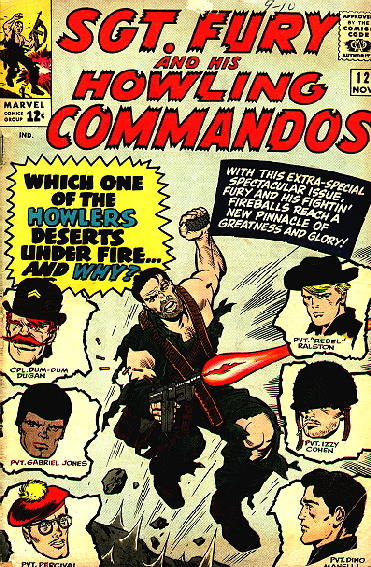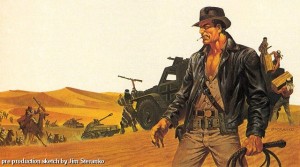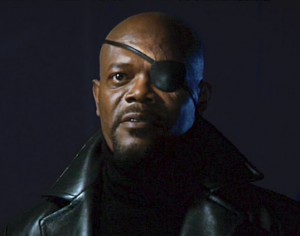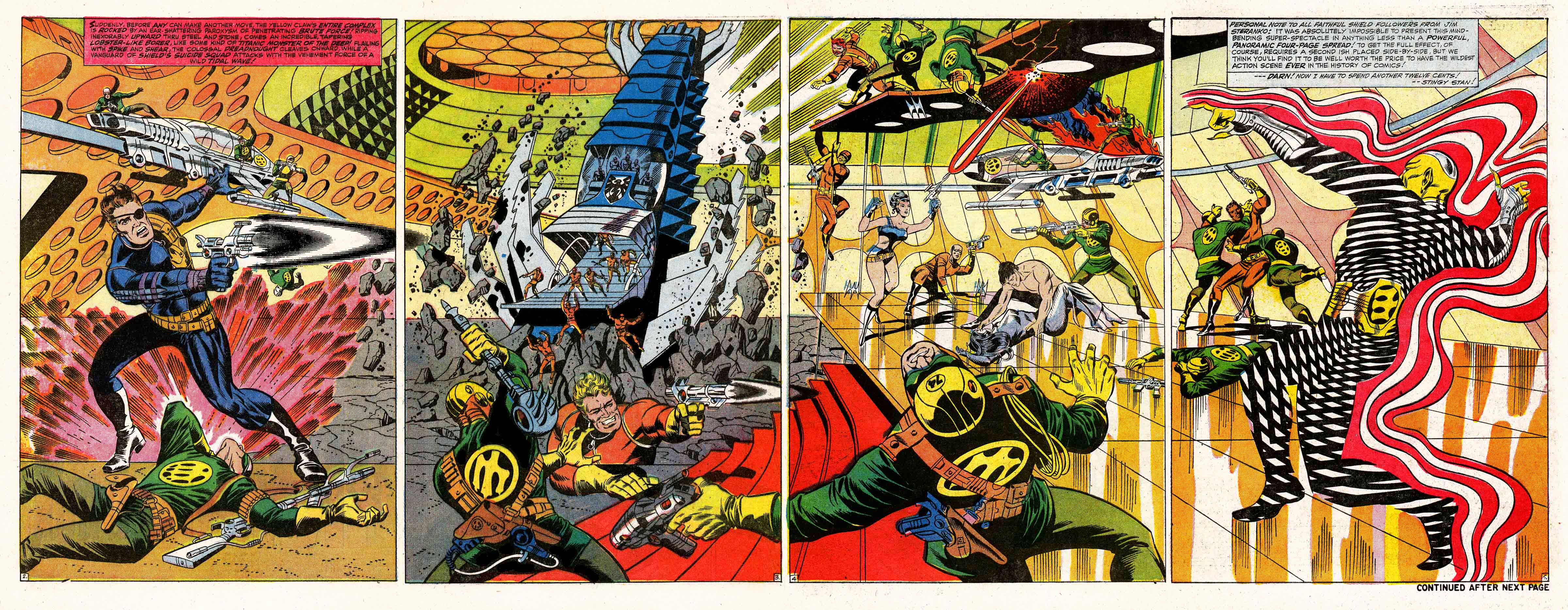 In the past seven years, who would have suspected the most important character to emerge from the Marvel Comics firmament would be Sgt. Nick Fury of the Howling Commandos (1963)? Nick Fury, later an agent of S.H.I.E.L.D., was always a second-to-third stringer; the kind of character that set things in motion for other characters more than initiating them himself. Even at the start when he was designed more as Marvel’s answer to DC’s Sgt. Rock, he was the blandest of the bunch compared to the more colorful types in his battalion. Later on, he’d lose his eye and gain control of the “Supreme Headquarters, International Espionage, Law-Enforcement Division” which was Marvel’s bid to infiltrate another genre — the super-spy society, which was all the rage in James Bond’s heyday.
In the past seven years, who would have suspected the most important character to emerge from the Marvel Comics firmament would be Sgt. Nick Fury of the Howling Commandos (1963)? Nick Fury, later an agent of S.H.I.E.L.D., was always a second-to-third stringer; the kind of character that set things in motion for other characters more than initiating them himself. Even at the start when he was designed more as Marvel’s answer to DC’s Sgt. Rock, he was the blandest of the bunch compared to the more colorful types in his battalion. Later on, he’d lose his eye and gain control of the “Supreme Headquarters, International Espionage, Law-Enforcement Division” which was Marvel’s bid to infiltrate another genre — the super-spy society, which was all the rage in James Bond’s heyday.
The comic book Fury was far more influenced by artist Jim Steranko, whose tripped-out styling and interconnected panel pages gave the S.H.I.E.L.D. comic a mod look that signified it as something altogether different on the comic book racks. It was one thing for the more popular Marvel characters — Fantastic Four, Spiderman — to occasionally utter “groovy,” but S.H.I.E.L.D. looked the part.
Steranko was known for his chiseled-jaw men-of-action types. In the late 1970’s/early 1980’s he’d be contracted by Lucasfilm to do production art for a movie they were making. Nothing was finalized yet, not even the look of the characters. But his rendering of a fedora-wearing, leather jacket sporting Raider made enough of an impact that costume designer Deborah Nadoolman used it as a fairly faithful base for how she’d eventually dress Harrison Ford…as Indiana Jones.
 But that’s about it for Fury. It wasn’t like Marvel didn’t try, in that obtrusive, all consuming way that they do. Things would get too real for the superhero set and, suddenly, the flying fortresses would descend and it was Fury on the case, but nothing ever quite stuck enough to make him a breakout. The same could be said of his early exploits, illustrating the twisted, tangled mess that occurs when ageless characters live in a world that has moved on. Fury was a contemporary of Captain America in WWII. They both fought the Red Skull. Captain America was frozen to near-death, explaining his missing-in-action status from the Big War to his modern (1960’s) resurrection, young as ever. Fury just lived on and on, yet didn’t age either. They’re comic book characters — overanalyzing them will break your brain.
But that’s about it for Fury. It wasn’t like Marvel didn’t try, in that obtrusive, all consuming way that they do. Things would get too real for the superhero set and, suddenly, the flying fortresses would descend and it was Fury on the case, but nothing ever quite stuck enough to make him a breakout. The same could be said of his early exploits, illustrating the twisted, tangled mess that occurs when ageless characters live in a world that has moved on. Fury was a contemporary of Captain America in WWII. They both fought the Red Skull. Captain America was frozen to near-death, explaining his missing-in-action status from the Big War to his modern (1960’s) resurrection, young as ever. Fury just lived on and on, yet didn’t age either. They’re comic book characters — overanalyzing them will break your brain.
I had always assumed that the super serum that turned 90-pound weakling Steve Rogers into super-strong Captain America was first tried out on Fury, that the cryogenic alibi was a ruse for something more sinister, that the U.S. was working on the same dark projects the Germans were, only they were more discrete and didn’t advertise ambitions to foster a “master race.” It’s all very arcane stuff, and it’s certainly not something that the various writers and artists of Fury’s tales over the years paid much concern over.
 Funny how things change when Marvel strikes gold with Iron Man in the movies decades later, casts Samuel L. Jackson who is nothing like the comic character and yet seems utterly plausible and perfect in the role on-screen, and makes him the sun around which Thor, Tony Stark, Cap, Bruce Banner/The Hulk, and all of the rest of the Avengers orbit. Even more, Disney (Marvel’s parent company) is creating a S.H.I.E.L.D. TV series. It will not star Jackson, Black Widow’s Scarlett Johanssen, or new-to-the-fold Cobie Smulders, still under contract for another season of How I Met Your Mother. Nonetheless, these characters will be entangled with the series somehow, if but from a distance.
Funny how things change when Marvel strikes gold with Iron Man in the movies decades later, casts Samuel L. Jackson who is nothing like the comic character and yet seems utterly plausible and perfect in the role on-screen, and makes him the sun around which Thor, Tony Stark, Cap, Bruce Banner/The Hulk, and all of the rest of the Avengers orbit. Even more, Disney (Marvel’s parent company) is creating a S.H.I.E.L.D. TV series. It will not star Jackson, Black Widow’s Scarlett Johanssen, or new-to-the-fold Cobie Smulders, still under contract for another season of How I Met Your Mother. Nonetheless, these characters will be entangled with the series somehow, if but from a distance.
It probably doesn’t mean all that much to the new audiences that will only know Fury as Jackson, and not be interested in the chronological breakdown of how he got from WWII to the modern day, because that isn’t even a plot point in the new origin, nor does it necessarily need to be. For one of the very few times I can recall, an actor was cast that is so against the type the roll called for, and now is the only one who could ever be seen filling it, that I don’t mind the considerable Ju Jitsu that the change does on the “mythology.”
However, I have to wonder what the comic’s creators would think. Nick Fury has come a very long way and, even in their lifetimes, it was clear that the character was never going to be a household name, based solely on the weak public reception he often got. Now he is exactly that. Everyone knows Sgt. Fury now.








Comments